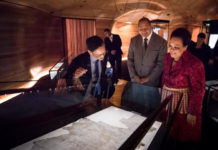Here are the four flag designs that eligible voters will rank in the first binding postal referendum this year, between 20 November and 11 December.
From the 10,292 alternative designs suggested to the Panel, four have been selected to be ranked by New Zealand in the first binding referendum this year.
Here you can learn more about these designs, see them in context and meet the people who designed them.
Silver Fern (Black & White) Designed by Alofi Kanter Official Description The dominant feature of this flag is a black and white fern frond. The fern frond sweeps diagonally up from the bottom left corner to the top right corner of the flag. The leaves and the stem on the top side of the fern are black on a white background. The leaves and the stem on the bottom side are white on a black background. Designer’s Description The fern has been a distinctive symbol of New Zealand for the past 100 years. Strong and simple, it represents our uniqueness as Aotearoa New Zealand and the black and white colours show our ‘yin and yang’, with the softly curved spine of the frond binding us all together as a young, independent and proud nation. Credit for the fern goes to The New Zealand Way Limited.
Silver Fern (Black, White and Blue) Designed by: Kyle Lockwood Official Description The dominant feature of this flag is a white fern frond that sweeps up diagonally from the bottom left corner to the right of the top centre. The left side of the fern is sitting on a red background. To the right of the fern there are four stars in the formation of the Southern Cross constellation, sitting on a blue background. Each star is red with a white border, and has five points. Designer’s Description The silver fern: A New Zealand icon for over 160 years, worn proudly by many generations. The fern is an element of indigenous flora representing the growth of our nation. The multiple points of the fern leaf represent Aotearoa’s peaceful multicultural society, a single fern spreading upwards represents that we are all one people growing onward into the future. The red represents our heritage and sacrifices made. Blue represents our clear atmosphere and the Pacific Ocean, over which all New Zealanders, or their ancestors, crossed to get here. The Southern Cross represents our geographic location in the antipodes. It has been used as a navigational aid for centuries and it helped guide early settlers to our islands
Koru Designed by Andrew Fyfe Official Description The right half of this flag is black. At the halfway point of the flag the black forms a koru on a white background. The black koru spirals down and to the left from the top of the flag. Designer’s Description As our flag unfurls, so too does its koru. The koru represents the fern frond, but is also reminiscent of a wave, a cloud, and a ram’s horn. In MÄori kowhaiwhai patterns the koru represent new life, growth, strength and peace, and for this reason has taken a special place in Aotearoa’s visual language.
Silver Fern (Red, White and Blue) Designed by: Kyle Lockwood Official Description The dominant feature of this flag is a white fern frond that sweeps up diagonally from the bottom left corner to the right of the top centre. The left side of the fern is sitting on a red background. To the right of the fern there are four stars in the formation of the Southern Cross constellation, sitting on a blue background. Each star is red with a white border, and has five points. Designer’s Description The silver fern: A New Zealand icon for over 160 years, worn proudly by many generations. The fern is an element of indigenous flora representing the growth of our nation. The multiple points of the fern leaf represent Aotearoa’s peaceful multicultural society, a single fern spreading upwards represents that we are all one people growing onward into the future. The red represents our heritage and sacrifices made. Blue represents our clear atmosphere and the Pacific Ocean, over which all New Zealanders, or their ancestors, crossed to get here. The Southern Cross represents our geographic location in the antipodes. It has been used as a navigational aid for centuries and it helped guide early settlers to our islands.











